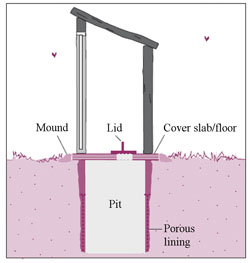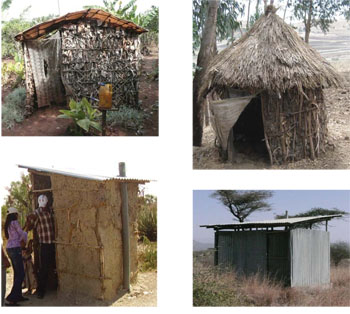Pit latrine with slab
Pit latrines are the simplest form of dry latrine. They consist of a pit dug in the ground and a cover slab or floor above the hole. Pit latrines must have a cleanable cover slab in order to be considered as improved sanitation systems. The excreta (both faeces and urine) drop through the hole to enter the dry pit. Pit latrines should be constructed on a slight mound so they are higher than the surrounding ground and water at the surface will flow away from the hole. They should also have a lid that can be placed over the hole to reduce problems with flies and odours. They may have a squat pan or a raised footrest to make using the latrine more convenient. The pit is often lined but the bottom remains open, allowing the liquid to drain into the soil and leaving the solids behind.

Pit latrines should also have an upper part, called the superstructure, to provide protection from the rain and sun, and privacy and comfort for the user.

Pit latrines can have a single pit or double pit. In double pits, while one is filling with excreta, the second pit remains out of service. When the first pit is filled with excreta up to about 50 cm below the slab, it is taken out of use and the remaining space is filled with grass and vegetation materials that can be composted. You then use the second pit until that is full. Meanwhile, the first pit will stay sealed for a period of 6–9 months, during which time the waste will decompose and any pathogenic microorganisms will die. After this period, the material (humus soil) in the first pit can be taken out manually. (Humus or humic is used to describe organic matter that has been stabilised by decomposition processes.) It is safe to handle and readily used as fertiliser in agriculture or can be disposed of safely.